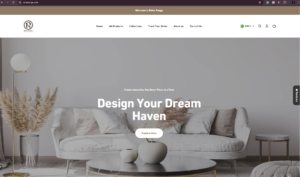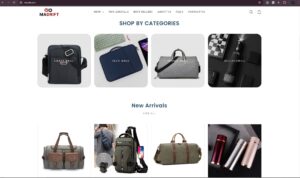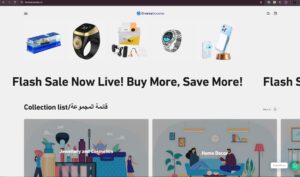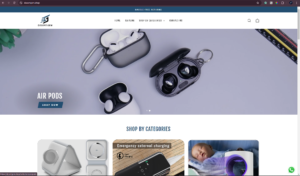E-commerce Website 🕸
Highlighting the need for a thoughtful approach to each aspect of your store’s design to enhance usability.
HOW WE CAN HELP
We’ll ensure that you focus on the opportunities
Choose the Right Platform
Selecting the right platform is the first step. Popular e-commerce platforms include:
- Shopify: Known for its ease of use and extensive app store.
- WooCommerce: A flexible, open-source platform for WordPress users.
- Magento: Suitable for larger businesses needing extensive customization.
- BigCommerce: Offers built-in features for scaling businesses.
Define Your Brand Identity
Your e-commerce website should reflect your brand identity. This includes:
Logo: Design a memorable logo that represents your brand.
Color Scheme: Choose colors that align with your brand’s personality and are consistent across the site.
Typography: Use readable fonts that complement your brand’s aesthetic.
Create a User-Friendly Layout
A well-organized layout enhances user experience. Consider the following elements:
Homepage: Design an engaging homepage with high-quality images, a compelling headline, and clear calls-to-action (CTAs). Highlight featured products, promotions, and new arrivals.
Navigation: Ensure your navigation is intuitive. Use categories and subcategories to help users find products easily. Implement a search bar with auto-suggestions.
Product Pages: Each product page should include high-quality images, detailed descriptions, pricing, and customer reviews. Use clear and visible CTAs like “Add to Cart” and “Buy Now.”
Supply ChainOptimize for Mobile
With the rise of mobile shopping, it’s crucial that your website is mobile-friendly:
Responsive Design: Ensure your site looks and functions well on all devices.
Mobile Navigation: Simplify navigation for mobile users with clear menus and easy access to important pages.
Fast Loading Times: Optimize images and reduce unnecessary scripts to improve loading speeds on mobile.
Focus on Visuals
High-quality visuals can make a significant impact:
Product Photography: Use professional images that show your products from multiple angles. Consider 360-degree views or videos for a better user experience.
Graphics and Banners: Use attractive banners to promote sales, discounts, or special events. Ensure they align with your brand’s color scheme and overall aesthetic.
Simplify the Checkout Process
A smooth and straightforward checkout process can reduce cart abandonment:
Guest Checkout: Allow users to purchase without creating an account.
Progress Indicators: Show users where they are in the checkout process.
Multiple Payment Options: Offer various payment methods, including credit cards, PayPal, and digital wallets.
Auto-fill and Validation: Use auto-fill for address fields and validate inputs in real-time to minimize errors.
Implement SEO Best Practices
Optimize your site for search engines to attract organic traffic:
Keywords: Conduct keyword research and use relevant keywords in product titles, descriptions, and meta tags.
Alt Text for Images: Use descriptive alt text for all images to improve visibility in image searches.
Internal Linking: Link to related products and categories to help search engines crawl your site and to keep users engaged.
Incorporate Customer Reviews and Testimonials
Social proof can build trust and encourage purchases:
Product Reviews: Allow customers to leave reviews on product pages. Display these reviews prominently.
Testimonials: Include customer testimonials on your homepage or dedicated testimonials page.
User-Generated Content: Showcase photos or videos from customers using your products.
Enhance Security and Trust
Build trust with your customers by ensuring their data is secure:
SSL Certificate: Ensure your site has an SSL certificate to encrypt data and secure transactions.
Trust Badges: Display trust badges from recognized security providers.
Transparent Policies: Provide clear information about shipping, returns, and privacy policies.
Analyze and Optimize
Continuous improvement is key to a successful e-commerce website:
Analytics Tools: Use tools like Google Analytics to track visitor behavior, conversion rates, and other key metrics.
A/B Testing: Experiment with different layouts, CTAs, and product displays to see what works best.
Feedback: Gather feedback from customers to identify areas for improvement and address any issues.
Client results
Some Samples!





Learn more
Frequently Asked Questions
An e-commerce website is an online platform that allows businesses to sell products or services to customers over the internet. It includes features such as product listings, a shopping cart, and secure payment gateways.
The choice of platform depends on your business needs. Shopify is user-friendly and great for beginners, WooCommerce offers flexibility for WordPress users, Magento is ideal for large businesses needing extensive customization, and BigCommerce provides robust features for scaling businesses.
Mobile optimization is crucial as a significant number of users shop via mobile devices. A mobile-friendly site enhances user experience, reduces bounce rates, and improves search engine rankings.
Improve user experience by ensuring fast loading times, providing intuitive navigation, using high-quality visuals, optimizing for mobile, simplifying the checkout process, and offering excellent customer support.
A successful homepage should include high-quality images, a compelling headline, clear calls-to-action (CTAs), featured products, promotions, and easy navigation. It should quickly convey your brand’s value proposition.
Product pages should include high-quality images, detailed descriptions, pricing, availability, customer reviews, and clear CTAs. Providing multiple images, videos, and comprehensive information helps customers make informed decisions.
Optimize your site by using relevant keywords in product titles, descriptions, and meta tags, creating high-quality content, ensuring fast loading speeds, using descriptive alt text for images, and implementing internal linking.
Customer reviews and testimonials build trust and provide social proof, which can influence potential buyers’ decisions. They show that other customers have had positive experiences with your products and services.
“I chose WooCommerce for its flexibility and it has been fantastic. As a tech enthusiast, I appreciated being able to customize my site extensively. The responsive design ensures my site looks great on all devices, and the ability to add new plugins has been invaluable for expanding my store’s functionality. My customers love the smooth shopping experience!”
Carol Oliveira

